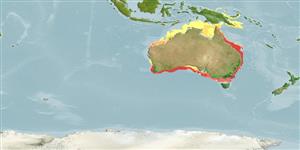أشلاق (القروش و الشفانين) (sharks and rays) >
Orectolobiformes (Carpet sharks) >
Orectolobidae (Carpet or nurse sharks)
Etymology: Orectolobus: orektos (Gr.), stretched out; lobus (L.), from lobos (Gr.), rounded projection or protuberance, referring to long nasal barbels of Squalus barbatus (=O. maculatus) (See ETYFish); ornatus: Latin for adorned or decorated, presumably referring to its color pattern, described as yellowish with broad dark crossbands (the hinder ones encircling the tail), and two dorsal bands with “deeply fretted edges”, each enclosing a pairs of ocelli; name could also refer to the “tentacular fringe” around the head (See ETYFish).
Issue
To be split. The subspecies O. o. halei is a valid species according to Huveneers 2006 (Ref. 58832).
Environment: milieu / climate zone / depth range / distribution range
البيئة
بحري مرتبطة بالشعاب; نطاق العمق 0 - 100 m (Ref. 54689). Tropical
Southwest Pacific: east Australia and southern Papua New Guinea.
Length at first maturity / الحجم / وزن / العمر
Maturity: Lm ?, range 94 - ? cm
Max length : 290 cm TL ذكر/ مختلط الجنس; (Ref. 6871)
الأشواك الظهرية (المجموع) : 0; شوكة شرجية: 0. Back with light areas between dark saddles marked with dark, light-centered blotches and spots, not reticulated lines (Ref. 13577). Caudal fin with its upper lobe hardly elevated above the body axis, with a strong terminal lobe and subterminal notch but no ventral lobe (Ref. 13577).
A common bottom shark of inshore continental waters, on algal-covered rocky areas and coral reefs (Ref. 247). Nocturnal, resting on the bottom during the day and prowling on its reef habitat at night (Ref. 247). Presumably feeding on bottom invertebrates and fishes but diet unrecorded (Ref. 13577). Ovoviviparous (Ref. 50449). Attacks waders and fishers in tide pools (Ref. 247). Interest to fisheries limited; its skin very tough and attractively patterned and utilized for leather (Ref. 13577).
Life cycle and mating behavior
النضج | التكاثر | وضع البيض | بيض | الخصوبة | Larvae
Ovoviviparous, embryos feed solely on yolk (Ref. 50449).
Compagno, L.J.V., 1984. FAO Species Catalogue. Vol. 4. Sharks of the world. An annotated and illustrated catalogue of shark species known to date. Part 1 - Hexanchiformes to Lamniformes. FAO Fish. Synop. 125(4/1):1-249. Rome, FAO. (Ref. 247)
IUCN Red List Status (Ref. 130435: Version 2024-1)
استخدامات بشرية
أدوات
تقارير خاصة
Download XML
مصادر علي الأنترنت
Estimates based on models
Preferred temperature (Ref.
123201): 15.3 - 26.7, mean 18.5 °C (based on 386 cells).
Phylogenetic diversity index (Ref.
82804): PD
50 = 0.5012 [Uniqueness, from 0.5 = low to 2.0 = high].
Bayesian length-weight: a=0.00389 (0.00180 - 0.00842), b=3.12 (2.94 - 3.30), in cm total length, based on all LWR estimates for this body shape (Ref.
93245).
مستوى غذائي (Ref.
69278): 4.0 ±0.60 se; based on food items.
المرونه (Ref.
120179): منخفض, الحد الزمني الأدني لتضاعف عدد أفراد المجتمع 4.5-14 سنة (tmax=20; K=0.19;).
Fishing Vulnerability (Ref.
59153): Very high vulnerability (90 of 100).
Nutrients (Ref.
124155): Calcium = 7.76 [1.75, 30.74] mg/100g; Iron = 0.33 [0.08, 0.92] mg/100g; Protein = 19.8 [17.6, 21.9] %; Omega3 = 0.0801 [, ] g/100g; Selenium = 46.2 [13.2, 130.7] μg/100g; VitaminA = 23 [8, 62] μg/100g; Zinc = 0.57 [0.28, 1.16] mg/100g (wet weight);
